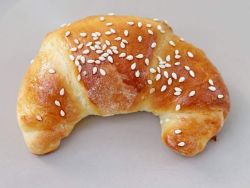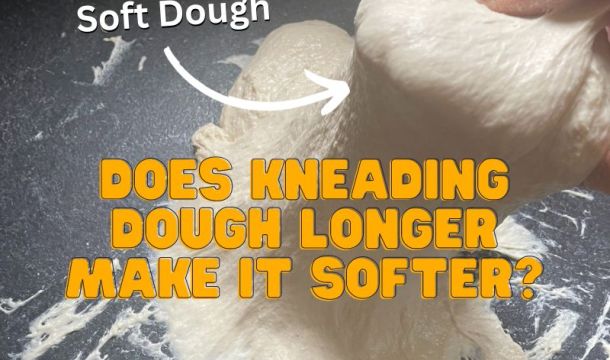
Finishing Bread Guide – Glazes, Washes, And Toppings

Bread is delicious, and it can be even more delectable when the crust is finished with a wash, glaze or topping! Whether it’s a crunchy crust or one that melts in your mouth that gets you excited, a well-thought-out finish makes all the difference. From a classic glaze to the fancier washes and toppings, there are many options for you to choose from.
Here are some of the most commonly-used glazes, washes and toppings and how to apply them to bread. They can transform a basic bread recipe (like my beginner’s bread recipe) into something much more interesting!
Glaze vs wash?
A glaze and wash are almost the same and the terms are often exchanged, yet there are a few differences.
- They vary in concentration. A wash is more watery, while a glaze is thicker.
- Glazes usually contain some type of sweetener (such as sugar or honey) and sometimes an acidic element like lemon juice. They can contain fatty ingredients too.
- The water in the glaze evaporates to create a crisp crust. Meanwhile, the sugars caramelise, creating colour and flavour. And the acids help break down the protein in the gluten, leading to a more tender crust.
- Glazes make bread shinny.
- Washes contain a fat, such as milk, egg, or buttermilk. The fat coats the surface of the bread while most of the liquid evaporates. The result is a beautifully glossy crust.
- They also differ in how they’re being applied to bread. Glazes are applied in a thin coat, which often requires a controlled manner. When applying a wash, you can be a bit more heavy-handed.
Types of bread washes and glazes
There are pre-bake and post-bake bread washes and glazes. The most common are listed below:
Pre-bake bread glazes and washes:
Egg wash
The most common wash in bread baking is a basic egg wash. It’s also popular in pastry too! An egg wash is usually applied before putting the bread in the oven to give them a nice shiny golden crust. Yet it is sometimes added at the start of proofing. In this case, the wash protects the dough from drying out.
An egg wash can also act as an adhesive for toppings to easily attach to the dough’s surface. The simplest way to make an egg wash glaze is by beating an egg. Salt is often included with the beaten egg (see FAQ’s), as well as water to thin the mixture. Variations include beaten eggs with milk, cream or by including just the yolk for a yolk glaze.
Cornstarch wash
Cornstarch wash gives the bread a soft bread crust with a little shiny finish. This is basically a cornstarch and water mixture, but it requires a bit of effort.
Bring 1/4 cup of water to the boil. Meanwhile, make a paste with 1 1/2 tsp of cornstarch and 2 tbsp of water. Add the paste to the boiling water and whisk to combine. Simmer for about 30 seconds until it thickens and turns translucent. Leave it to cool down to room temperature, then brush it onto your bread before baking.
Milk glaze
Brushing bread dough with a glaze of milk before baking produces a darker coloured crust. This is because of the sugar and fat contents in the milk. A milk glaze produces a fairly matte finish compared to other glazes, but it is still slightly shinier than an unglazed loaf surface.
Sugar water glaze
To give your bread a matte finish, a nice darkened crust and a hint of sweetness, a sugar water glaze is great. It’s as simple as combining boiling water with sugar, whisking to dissolve the sugar and brushing it over your bread. For the described benefits, the glaze should be added before putting the bread in the oven.
For a sticky, sweet and shinier glaze, you can also brush this over the bread after it is baked. You can also experiment by adding sweet flavours to the glaze such as vanilla or orange. I often make a simple sugar water glaze for topping brioche bread.
Melted butter glaze
Using a melted butter glaze on your bread will not make it as shiny as an egg does. But it will make the crust soft and give a slightly yellow colour with an emphasis on darker parts. The downside of using melted butter is that it can leave your bread with a greasy texture. If you prefer a shinier finish, you can also apply this to your bread after baking.
Post-bake bread glazes:
Honey
Honey is one of the most common post-baking bread glazes. It produces a shiny texture without affecting the colour of the crust all that much. Honey has an adhesive property and with its sweet flavour, it’s a great pair for fruit-based types of bread.
Olive oil
Olive oil can be drizzled over bread after baking. It enhances the bread with its rich flavour, while it smoothens and softens the crust at the same time. This is good for more rustic-style types of bread and looks fantastic!
Butter rub
Butter rub is commonly used when roasting meat, but it can also give your bread a shiny, golden crust. Simply mix the butter with flour, and combine it nicely. It can be used as an all-purpose rub or added to any other seasoning you want to use on your bread.
Beurre noisette (brown butter) wash
If you’re looking for something richer and more sophisticated than regular washes, you should try brown butter. This wash is melted butter with a more accelerated flavour. As you cook the butter, it will have some brown specks. Applying this to bread can give them a shinier finish with an additional nutty aroma.
Apricot jam
Apricot jam is a pastry chef’s favourite. Warm some jam in a small cup in the microwave. Once boiling, add a dash of water and stir to a thin, shiny consistency. It has so many uses! Make a savoury loaf shiny and sweet, enhance a sweet bread or pastry, and use it to stick flaked nuts or almonds to the croissants. Apricot jam is perfect!
Spiced apple and cider glaze
Perfect for hot cross buns at Easter! Boil some sugar water in a bowl, and add apples (you can use peelings and cores). Simmer with a vanilla pod and mulled wine spices for 1 hour. Add a bottle of cider and continue to simmer until the glaze thickens up. Adjust sweetness to taste.
How to apply a glaze or wash to bread
There are a couple of ways how to apply a glaze or wash to your bread:
Using a pastry brush
Using a pastry brush is probably the most common way of applying glaze to homemade bread. There are a variety of brushes to choose from, and they come in different types and sizes.
They’re usually made out of animal hair or nylon, but plastic ones are also available. You can simply dab the brush on your glaze and brush it onto your bread thoroughly. Wider brushes like this one make applications much quicker.
Kitchen towel
Dip a folded piece of kitchen towel in the glaze and rub it over the bread. This provides an even coverage however regular dipping and applications will be required so expect this method to take a while if you have a lot of bread to glaze – if you only have a few loaves it’s perfect!
Using a spray bottle
A spray bottle is also a good way to add glaze to bread. You can use different types of food-safe spray bottles, but keep the nozzle safe from being clogged by not using it with glazes that contain flour or dry ingredients.
Using a spoon
Dropping some glaze over your bread is quicker than brushing it all over the surface, yet the likelihood of adding too much glaze is high. I wouldn’t use this method unless you are trying a particular technique. You can use a measuring cup with rounded edges to get more circular drops of glaze on the bread.
Using your fingers
If you’re out of any options, you can use your fingers to apply your glaze. This will work when applying a dry product like a butter rub. If you’re going to apply wet glazes you will struggle. Aim for a thin layer and spread it evenly over the surface of your bread.
Toppings for bread:
There are different varieties of toppings that you can apply to bread before or after baking:
Confectioners’ Sugar
Sprinkling confectioners sugar over the finished product is an easy way to top your bread before serving.
Salt
Salt is one of the most common toppings, and it’s also best to use this after baking. If you put salt before or during cooking, it can make your bread soggy and not as enjoyable. But if you decide to use salt as a final touch, always remember that less is more! Putting too much can overpower the flavour of the bread, so use a light hand when sprinkling!
Herbs and Spices
Herbs and spices can also be added before or after the baking stage. But make sure to add them in moderation since they can be quite potent. Popular herbs and spices to sprinkle on bread are thyme, rosemary, oregano, paprika, and cayenne pepper. If you find that they are burning in the oven, consider placing them on the bread just for the last 5-10 minutes of baking.
Seeds and nuts
Toasting nuts or seeds separately and then applying them after the bread has baked is a popular method. Use a glaze as an adhesive and sprinkle sesame seeds, flaked almonds or dried coconut on top.
When to add toppings to bread?
The majority of toppings such as seeds, cheese, and oats should be applied to the bread dough right after it is shaped. For maximum coverage, wet either the seeds or the shaped dough with a water mister. Then roll the dough into the seeds. This will evenly coat your bread, ready for proofing.
Do you need to add salt to an egg wash?
Adding salt to an egg wash that is going to be applied right before baking is beneficial. The longer an egg wash with salt is exposed to air, the quicker it deteriorates. If applying an egg wash to bread before it is to be proofed, it is best not to add salt.
Salt breaks down the protein in the egg whites. If it’s included in an egg wash it will make the wash runnier, thinner and easier to apply. This is great if the egg wash is applied shortly before baking. But egg wash naturally becomes like this over time, therefore adding salt to an egg wash which is used on the dough before a long proof is detrimental. The egg wash can turn rancid.
Frequently asked questions about glazes and washes
If you’ve enjoyed this article and wish to treat me to a coffee, you can by following the link below – Thanks x

Hi, I’m Gareth Busby, a baking coach, senior baker and bread-baking fanatic! My aim is to use science, techniques and 15 years of baking experience to make you a better baker.
Table of Contents
Related Recipes
Related Articles
Latest Articles
Baking Categories
Disclaimer
Address
53 Greystone Avenue
Worthing
West Sussex
BN13 1LR
UK







